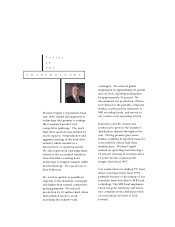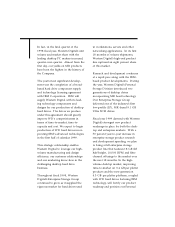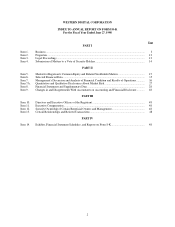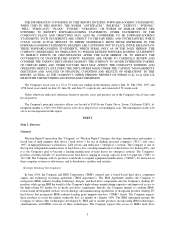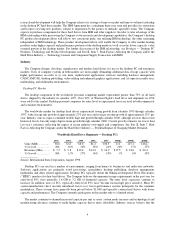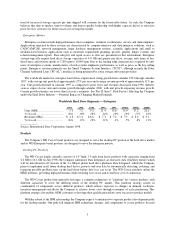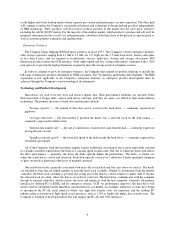Western Digital 1998 Annual Report Download - page 12
Download and view the complete annual report
Please find page 12 of the 1998 Western Digital annual report below. You can navigate through the pages in the report by either clicking on the pages listed below, or by using the keyword search tool below to find specific information within the annual report.
7
Storage capacity of the hard drive is determined by the number of disks and each disk's areal density, which is a
measure of the amount of data that can be stored on the recording surface of the disk. Areal density is generally
measured in megabits per square inch of disk surface. The higher the areal density, the more information can be stored
on a single platter. As the areal density increases, fewer disks and/or heads are required to achieve a given drive
capacity. For example, a 5 GB drive with areal density of 2.1 GB per disk will require three disks and five heads.
With an areal density of 2.5 GB per disk, the same capacity can be achieved with two disks and four heads, with
resulting component cost savings. The Company employs a range of advanced technologies to achieve high densities,
including PRML (Partial Response Maximum Likelihood) read/write channels, advanced servo systems, and laser
textured media.
Head technology is one of the variables affecting areal density. The desktop hard drive industry is completing a
transition to MR head technology, which allows significantly higher storage capacities than thin film head
technologies. Certain of the Company's competitors in the desktop hard drive market moved more quickly than the
Company into MR head technology, achieving time-to-market leadership at higher capacity points. The Company
pursued a strategy of a more deliberate transition to this new technology in order to take advantage of the hard drive
industry's MR technology learning curve. In the interim, the Company continued to refine and rely upon thin film head
technology for its products. The Company began volume shipments of its first MR-based hard drive products for the
desktop market in the first quarter of 1998, and substantially completed its transition of desktop hard drives to MR
head technology by the end of 1998. The Company continues to manufacture drives with thin film inductive heads for
the lower capacity points of the enterprise market.
Constant innovations in research and development are essential to the Company's ability to compete. In particular,
the Company must continue to develop hard drive products that deliver ever-increasing storage capacities. Areal
density improvement is essential to this effort because increased areal density per platter helps manufacturers reduce
component costs and maintain average margins. The IBM Agreement is expected to help enable the Company to
provide market-leading products in the higher end of the desktop PC market, but the Company must continue its own
independent research and product development efforts to compete in the enterprise and low-cost desktop PC markets.
The Company must expand its product offerings in the enterprise market to include half high (1.6" high), FC-AL
interface, and 10,000 rpm drive products. The Company's current line of enterprise products consists of SCSI low
profile 1" high drives with capacity points up to 9.1 GBs. While these products address approximately 70-80% of the
enterprise market, that percentage is likely to decrease as demand for FC-AL interface and 10,000 rpm drive products
grows. Technology available to the Company under the IBM Agreement is limited to the desktop PC market and may
not be used by the Company in its enterprise products, so the Company's own research and development is crucial to
its success in the enterprise market. The Company is currently in the product design and development phase of these
additional enterprise products, and expects to bring them to market during the next 18 months. If the Company is unable
to build its enterprise infrastructure quickly enough to support this development schedule or encounters development
delays or quality issues, it may miss the time-to-market windows on these new enterprise products.
Sales and Distribution
The Company sells its products globally to OEMs, OEM subcontractors ("ODMs"), distributors, value-added
resellers, dealers, system integrators and retailers. Sales to OEMs accounted for 68%, 72% and 69% of consolidated
revenues in fiscal years 1996, 1997 and 1998, respectively. Western Digital hard drives are either incorporated into
computer systems for resale or installed into end user systems as upgrades.
The business models of computer manufacturers, which account for the majority of the Company's sales, are in the
process of changing, and these changes have impacted and will continue to impact Western Digital's sales, inventory
and distribution patterns. The forecast-driven, long-production-run logistics model, which most of the computer
industry has used, exposes OEMs and others in the distribution chain to the risk of carrying excess or obsolete
component inventories. The historical model limits the OEMs' flexibility to react to rapid technology changes and
component pricing fluctuations. The Company is beginning to experience a new customer supply chain logistics model
that combines "build-to-order" (OEM does not build until there is an order backlog) and "channel assembly" (OEM or
component suppliers provide kits and/or parts to dealers or other assemblers who assemble the computers). The
Company is adapting its logistics model to effectively align with this industry shift. Western Digital already operates
within these models with two of its major OEM customers. These changes will require greater skill in managing



